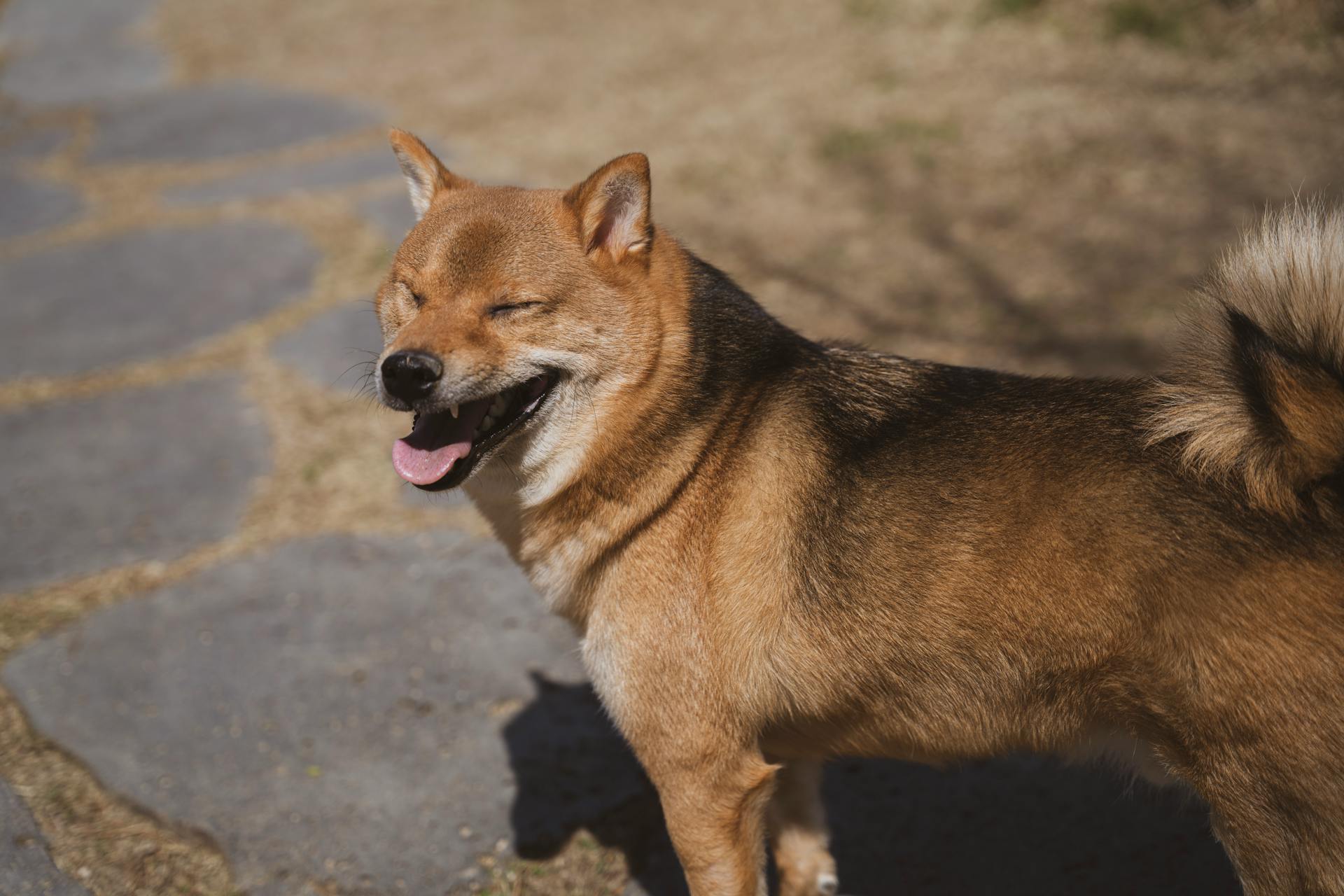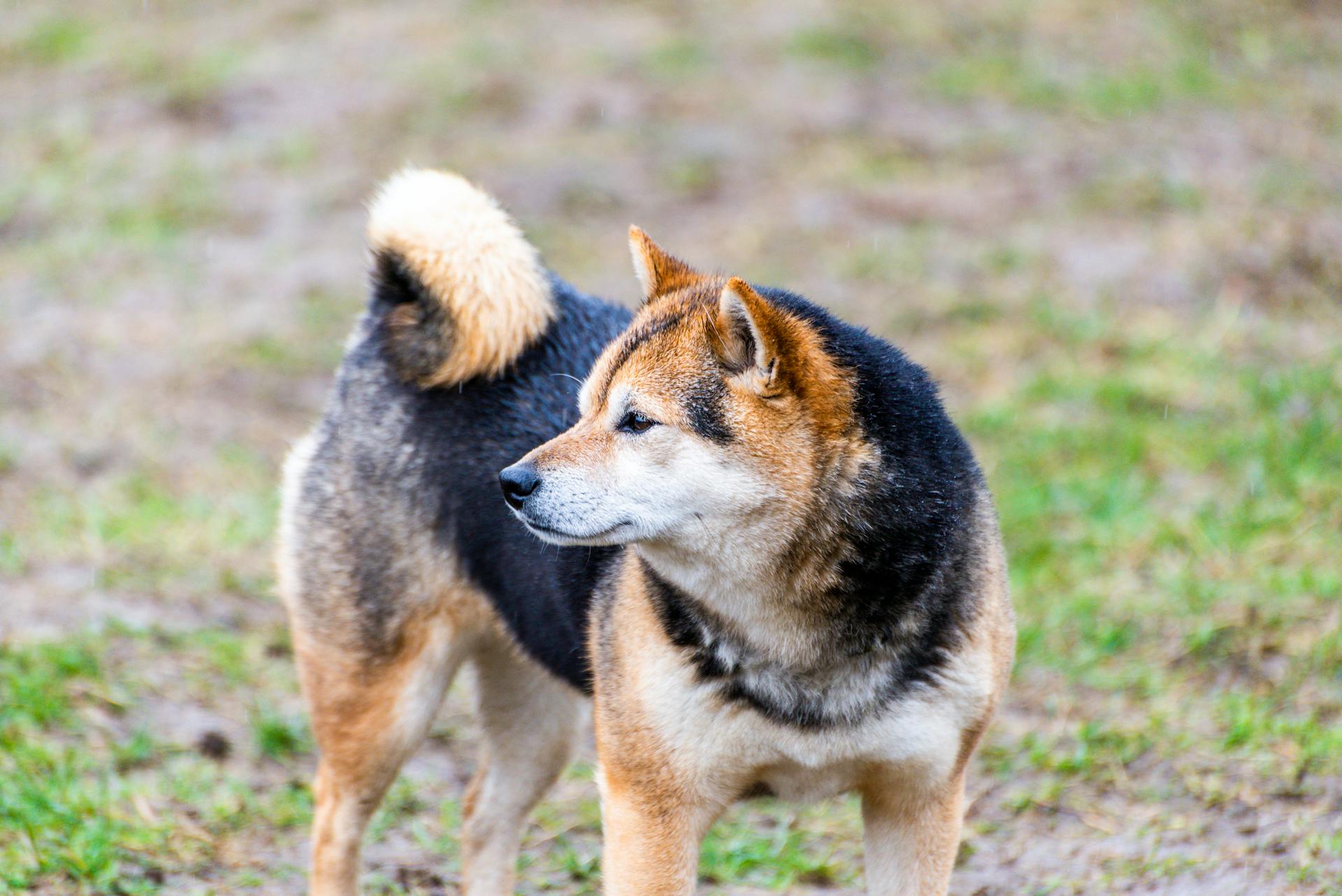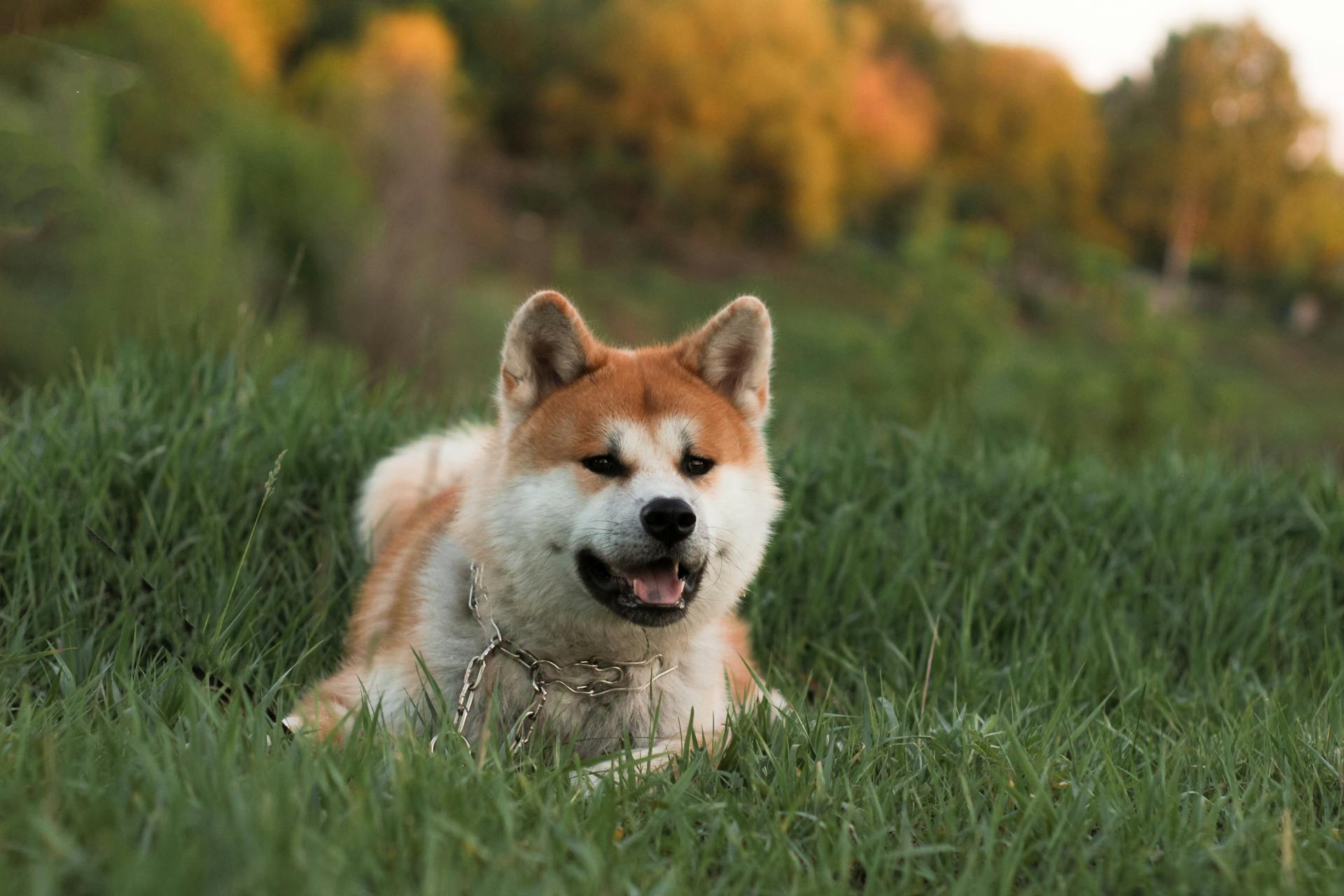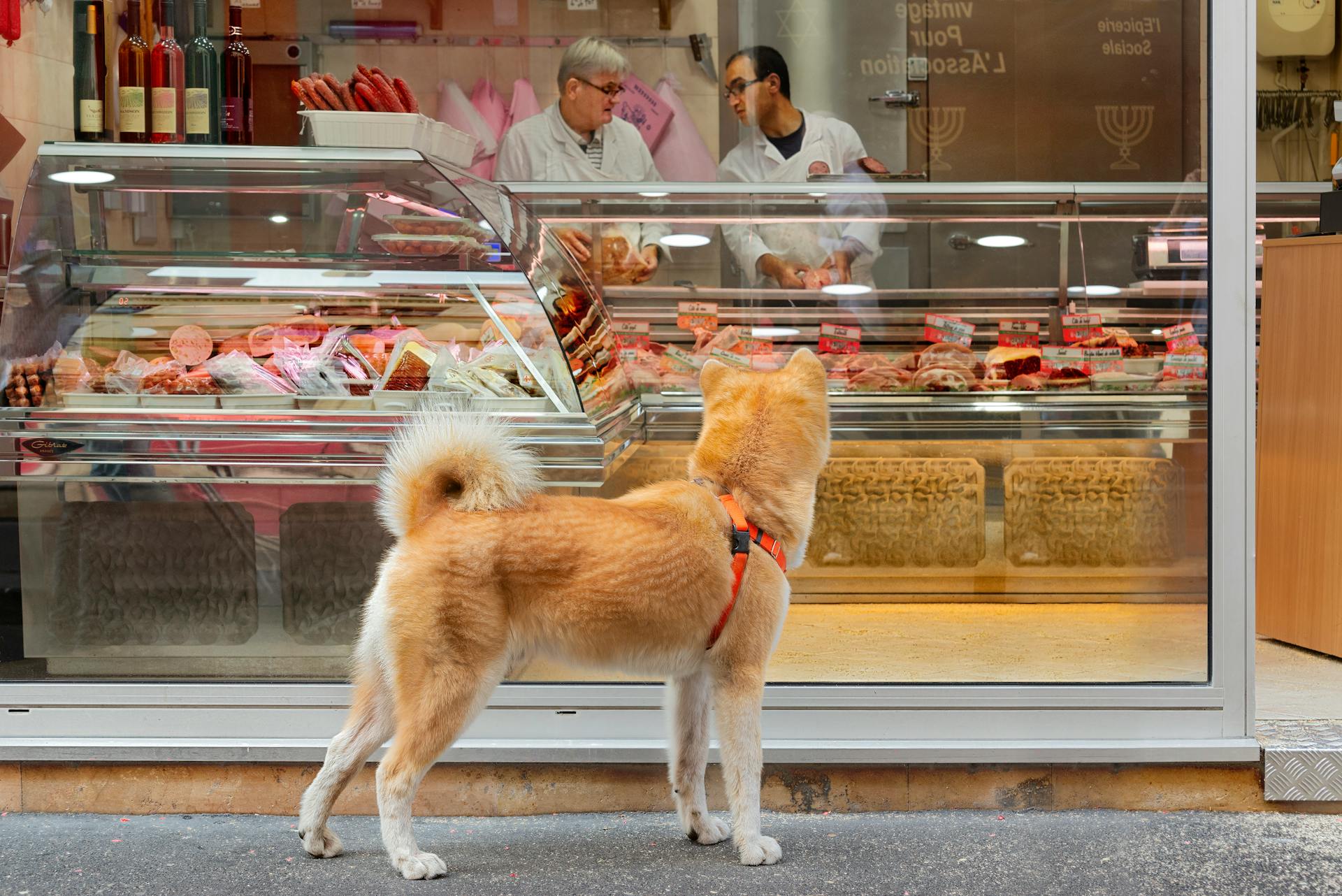
The Shiba dog breed is an ancient one, originating from Japan over 3,000 years ago.
They're known for their fox-like appearance and independent nature.
Shibas are a relatively small breed, weighing between 15-25 pounds and standing about 13-17 inches tall at the shoulder.
These dogs are highly intelligent but can be stubborn at times, making training a challenge.
Characteristics
The Shiba Inu is a unique breed with some wonderful characteristics that make them great companions.
Their personality is generally reserved, but they can be very affectionate and attentive to their owners.
Shibas are highly intelligent dogs, which means they're capable of learning quickly and adapting to new situations.
However, this intelligence also comes with a bit of stubbornness, so consistent training and patience are key.
With proper socialization from an early age, Shibas can do well with other dogs and kids in the household.
In terms of exercise needs, Shibas require moderate activity to stay happy and healthy. A daily walk or playtime should suffice.
Here's a quick rundown of some of their notable characteristics:
Overall, Shibas are wonderful companions that require patience, consistency, and moderate exercise.
History
The Shiba Inu has been around for a long time - its history dates back to 300 BC in Japan.
It was originally bred by hunters to help them flush out small game like birds and rabbits.
Shibas lived in the mountainous areas of the Chūbu region, where they used their skills to hunt in the wild.
The breed's name "shiba" means brushwood in Japanese, possibly referring to its reddish coat color or its ability to flush animals from the brush.
During the Meiji Restoration, western dog breeds were imported and crossed with native Japanese breeds, which led to a decline in pure Shiba numbers.
Take a look at this: Breeds like Shiba Inu
They Were Bred As
The Shiba Inu was bred to hunt and flush small game.
Dogs with a similar appearance to the Shiba Inu were used for hunting during the prehistoric Jomon period of Japanese history.
Shibas have a keen sense of smell and hearing, making them well-suited for tracking down animals like birds and rabbits.
The breed's original purpose was to hunt small game such as birds and rabbits in the mountainous areas of the Chubu region.
Here's an interesting read: Shiba Inu Terrier Mix
An Ancient Ancestor in Sagamihara

The Shiba Inu has a rich history that dates back thousands of years.
In Japan, this breed was first used by hunters to flush out small game as far back as 300 BC. The name "Shiba" means brushwood in Japanese, and "inu" means dog – likely referencing the dog's ability to flush animals out of the brush.
The Shiba Inu was bred to hunt and flush small game, such as birds and rabbits. It lived in the mountainous areas of the Chūbu region.
During World War II, the Shiba nearly became extinct due to a combination of food shortage and a post-war distemper epidemic. All subsequent dogs were bred from the only three surviving bloodlines: the Shinshu Shiba, Mino Shiba, and San'in Shiba.
These three strains were combined into one overall breed, the Shiba Inu, when the study of Japanese dogs was formalized in the early and mid-20th century.
Here's an interesting read: Little Poodle Dog
Care and Health
To keep your Shiba Inu happy and healthy, regular exercise is a must. Aim for daily walks or playtime to meet their moderate energy needs.
Shibas need mental stimulation too, so engage them with activities that challenge their minds. This can be as simple as hiding treats around the house or playing interactive games.
To prevent joint problems, periodic joint examinations are recommended throughout your Shiba's life. These exams should start early and continue into adulthood to catch any potential issues before they become major concerns.
Some common health conditions in Shibas include allergies, hip dysplasia, eye problems like glaucoma and cataracts, luxating patella, and entropion. Regular veterinary check-ups can help identify these issues early on.
Here are some key health considerations for your Shiba Inu:
- Allergies
- Hip dysplasia
- Eye problems (glaucoma, cataracts)
- Luxating patella
- Entropion
By two years of age, your Shiba Inu may be considered fully free from joint problems if none have previously been discovered.
[Health]
The Shiba Inu is generally a healthy dog breed with a long lifespan. They can live up to a good age if properly cared for.
One health condition that affects this breed is allergies. If your Shiba Inu has allergies, you may notice symptoms such as itching or skin irritation.
You might enjoy: Tan Shiba Inu

Shibas are also prone to eye problems, including glaucoma and cataracts. Regular eye tests should be performed yearly to catch any issues early on.
Hip dysplasia can occur in Shibas, which is a condition that affects the hip joint. Periodic joint examinations are recommended throughout your dog's life to monitor for this issue.
Luxating patella is another health problem that may affect your Shiba Inu. This is where the kneecap slips out of place, causing discomfort or pain.
Here are some common health issues that can affect Shibas:
- Allergies
- Glaucoma
- Cataracts
- Hip dysplasia
- Luxating patella
By two years of age, your Shiba Inu should be fully developed and free from joint problems if none have previously been discovered.
Life Span
The average life expectancy for a Shiba Inu is from 12 to 15 years.
Regular exercise is essential for this breed, and daily walks are particularly beneficial for their overall health and well-being.
Pusuke, a remarkable Shiba mix, held the Guinness World Record as Longest Living Dog in 2010, living an impressive 26 years and eight months.
This exceeds the average life span of a Shiba Inu by nearly double, demonstrating the importance of proper care and attention for these dogs to live long and healthy lives.
Existential Threat

The Shiba Inu breed has faced two significant existential threats throughout history.
One instance occurred during the Meiji Era (1868-1912) and intensified during the Taisho Period (1912-1926), when Japan imported western dog breeds, leading to nearly all pureblood Shiba Inus being lost.
The Education Ministry in Japan made indigenous dogs national monuments to preserve their bloodline.
Scholars and hunters recognized a need to protect this breed, so they established the Nihon Ken Hozonkai (Japanese Dog Preservation Society) in 1928.
This society holds shows for indigenous dogs twice a year and awards prizes for excellence. It also provides guidance on breeding.
The second instance of near-extinction occurred during World War II due to food shortages, post-war depression, and bomb raids that greatly decreased their numbers.
An epidemic of distemper after the war nearly wiped out the breed, but breeding programs helped their numbers return to normal.
Training & Exercise
Training a shiba inu requires persistence and patience due to their strong-willed nature.
They can be quite stubborn and engage in training sessions only when they want, making it essential to start training from a young age to prevent bad habits from forming.
Use positive reinforcement methods like treats and praise to keep your dog's attention during training.
One aspect of training that often comes easily for shiba inus is housebreaking - these dogs don't like making a mess in their indoor space and appreciate being let outside to relieve themselves.
For socialization, expose your shiba to different people, other dogs, and various locations from a young age to boost its comfort and quell some of its standoffish nature.
Many shibas tend to be wary of strangers, though they typically aren't excessive barkers.
Here are some key points about training and exercise for shiba inus:
- Shibas need between 40 and 60 minutes of exercise every day to satisfy their energetic personalities.
- Aim to include off-lead activity, but be careful as they're expert escape artists - a securely fenced area is essential.
To keep your shiba mentally stimulated and prevent boredom, indulge their playful side with toys and games that challenge their problem-solving skills.
Their inquisitive nature means they love games that bring out their cunning side, such as hiding food treats around the garden for them to find.
Grooming and Nutrition
Shiba Inus are relatively easy to groom, requiring a weekly brush to remove loose fur and prevent tangles and mats.
Their coat stays fairly clean, but they do need an occasional bath, roughly every month, depending on how dirty they get.
It's also essential to check their ears weekly for cleaning and trim their nails around once a month. Don't forget to brush their teeth daily.
As for diet and nutrition, make sure to feed them quality, nutritionally balanced food with fresh water always available. Two measured meals per day are common, but it's best to discuss the quantity and type of food with your vet to ensure you're meeting their individual needs.
Appearance
The Shiba Inu's compact frame is a result of well-developed muscles.
Their double coat consists of an outer layer that's stiff and straight, and an undercoat that's soft and thick.
Fur on their foxlike face, ears, and legs is short and even.
Guard hairs stand off the body, about 4 to 5 cm (1+1⁄2 to 2 in) long at the withers, protecting underlying skin and repelling rain or snow.
Tail hair is slightly longer and stands open in a brush, making their tails a defining characteristic.
The required markings known as "urajiro" are not visible on cream-colored Shiba Inus.
Nutrition
Feeding your Shiba Inu requires some thought and attention to their individual needs.
Make sure to have fresh water available at all times for your dog to stay hydrated.
Feed two measured meals per day, as this is a common feeding schedule for Shibas.
Discuss the quantity and type of food with your vet to ensure you're meeting your dog's nutritional requirements.
Some Shibas can be picky eaters, so be prepared to try different dog foods if needed.
Treats should be monitored closely to avoid overfeeding your Shiba Inu.
A balanced diet of good quality dry dog food will help maintain your Shiba's healthy weight and compact body shape.
Frequently Asked Questions
Is a Shiba Inu a good family dog?
Shiba Inus are suitable for families with older children who can participate in exercise and training. However, they may not be ideal for households with very young children or babies
Are Shiba dogs expensive?
Yes, Shiba Inus can be expensive, with prices ranging from $1,400 to $3,500 depending on factors like breeder reputation and bloodline. If you're considering bringing a Shiba home, understanding these costs is essential for planning ahead.
Are Shiba dogs friendly?
Yes, Shiba Inus are generally friendly and loyal dogs. However, they may require extra supervision around children due to their impulsive nature.
Is Shiba a difficult dog?
Yes, Shiba Inus are considered a challenging breed due to their independent nature and potential stubbornness. However, with patience and experience, they can make loyal and loving companions for the right owner.
Why is Shiba Inu so popular in Japan?
Shiba Inus are extremely popular in Japan due to their intelligence, loyalty, and high energy level, making them a beloved companion for many families. Their origins as small hunting dogs also contribute to their popularity, as they require regular exercise and playtime.
Sources
- https://www.thesprucepets.com/shiba-inu-dog-breed-profile-4775761
- https://www.timeout.com/tokyo/things-to-do/things-you-didnt-know-about-shiba-inu-japans-native-dog-breed
- https://www.tokyoweekender.com/art_and_culture/japanese-culture/shiba-inu-history-japan/
- https://kids.kiddle.co/Shiba_Inu
- https://www.petplan.co.uk/pet-information/dog/breed/shiba-inu/
Featured Images: pexels.com


